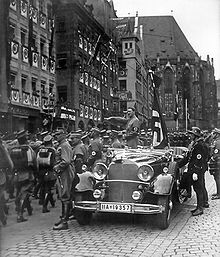Blood flag (NSDAP)

The blood flag was the official name for the specimen of the swastika flag that was carried along by Hitler's supporters in the attempted Hitler putsch against the Reich government , the so-called march on the Feldherrnhalle in Munich on November 9, 1923 . It was made a cult object of the NSDAP.
The NSDAP adopted the term blood flag , which was already used in the Holy Roman Empire , for its party rituals.
Emergence
In the attempted coup on November 9, 1923 in Munich, cited by Hitler and Ludendorff, there was an exchange of fire with the Bavarian police on Residenzstrasse in front of the Feldherrnhalle, in which 16 National Socialists, four state police officers and an uninvolved passer-by died. Allegedly the blood of the SA men Andreas Bauriedl , Anton Hechenberger and Lorenz Ritter von Stransky-Griffenfeld who were shot in the process soaked a swastika flag carried by Heinrich Wilhelm Trambauer . After the battle, he fled to a friend's house. Trambauer hid the flag until Hitler was released from prison in 1924, after which he handed it over to Hitler. The flag received a new pole and point as well as a plaque on which the names of the SA men who were killed were engraved.
On July 4, 1926, Hitler presented the blood flag to SS-Reichsführer Joseph Berchtold and entrusted it for safekeeping. From an organizational point of view, he and his organization, the SS , had to submit to the Supreme SA leadership .
Use as a relic
With the blood flag, following medieval traditions from 1926 onwards, all party flags and standards of SA and SS units were "consecrated" at all party congresses. Between the party congresses, the relic in memory of the “ martyrs ” was kept in the “Hall of Honor of the SA” in the NSDAP's office in Munich until 1931, then in the “flag hall” of the Brown House . In all ceremonies and parades, the blood flag was basically carried out by Jakob Grimminger , who took part in the Munich putsch of November 9, 1923 and was most recently appointed the official bearer of the blood flag with the rank of "SS standard leader", or Heinrich Wilhelm Trambauer († 1942 ) carried.
Whereabouts
It has often been claimed that the blood flag was last seen in public at the funeral of Adolf Wagner , the Gauleiter of Munich-Upper Bavaria in April 1944. In fact, it was used for the last time at the summoning ceremony of the Volkssturm on October 18, 1944. The ceremony was performed by Heinrich Himmler ; Also present were Wilhelm Keitel , Heinz Guderian , Hans Heinrich Lammers and Martin Bormann .
Presumably, the flag was then brought back to the Munich Brown House.
Some claim that it is now owned by a private collector in northern Germany; others suspect it was destroyed in an Allied bombing raid . The Brown House was completely destroyed by an air raid on Munich on January 7, 1945, its ruins were looted in the post-war period and demolished in 1947.
See also
Web links
- Bernhard Schäfer: blood flag of the NSDAP . In: Historical Lexicon of Bavaria
Individual evidence
- ↑ The sanctuary under the bloated Nazi symbolism was the "blood flag", which conveyed both "suggestive magic" and pure propaganda. In: Dorsten under the swastika. Wolf Stegemann, May 28, 2012, accessed on March 21, 2016 .